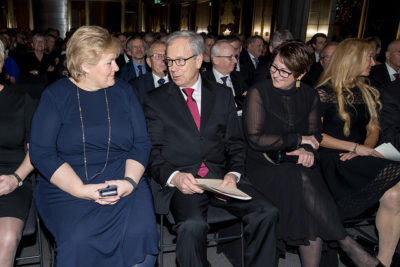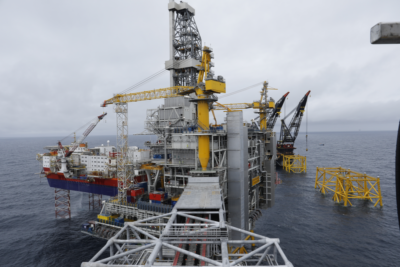NEWS ANALYSIS: Norway’s oil industry and its supportive Norwegian government have won backing from the country’s central bank chief to keep on pumping and looking for more offshore oil and gas reserves. In an annual and much-followed speech Thursday evening, Øystein Olsen also opted against commenting on how the government spends Norway’s oil revenues, for the first time in eight years.

Olsen’s annual address as governor of Norway’s central bank (Norges Bank) must have been music to the years of both the country’s conservative government coalition and the oil and gas industry. Both are bullish on the oil business because of all the revenues and jobs it creates, but are under increasing pressure to finally cut back on oil production and exploration because of ever-growing concerns about all the carbon emissions it generates.
The government and the oil business won a vote of confidence of sorts from Olsen in his traditional annual speech called “Economic perspectives.” In the audience, as usual, were government ministers, the CEOs of Norway’s biggest companies and leaders of major Norwegian political parties, labour, media and other civic organizations.
Olsen used many of the same creative arguments promoted by the government and oil industry advocates to justify current oil and gas production, ongoing oil exploration and continuation of tax incentives for it, despite all the visible climate change that’s already occurring. Olsen sounded much like Norway’s bullish oil minister Kjell-Børge Freiberg and the CEO of Norwegian state oil company Eldar Sætre, when he claimed that Norwegian oil and gas are produced in a more environmentally friendly manner than in other countries, that Norwegian gas can offset the use of coal in European markets, that any cuts in exploration and production off Norway would simply be replaced elsewhere, and that Norwegian emissions-cutting measures “are working,” even as Norway’s own emissions rise.
While Olsen acknowledged a need to eventually restructure Norway’s economy (to make it less dependent on oil and gas) he offered no suggestions as to when that should get underway in earnest. It won’t happen during the next several years, at any rate, with Olsen confirming how oil production is instead expected to hit new highs despite a 2030 deadline for major carbon emission cuts. Olsen remained optimistic that Norwegians are clever at restructuring, when they finally feel compelled to do so.

So far the government continues to give a green light to oil industry expansion, and Olsen seems to think that’s fine. In addition to holding the speech itself, Olsen granted various pre-speech sessions to major Norwegian media outlets, and said he thinks it would be wrong to simply curtail production or exploration.
“It’s simply a fact that oil and gas are very profitable and have given Norway great income,” Olsen told newspaper Dagens Næringsliv (DN) for example, and called oil “an engine” for the Norwegian economy for nearly 50 years. “It’s difficult to find a business that gives the nation and the state such great revenues,” he said before his speech. “I warn against turning off oil pumps, apart from those that aren’t profitable.” He also warned to DN, state broadcaster NRK and Aftenposten that changing the framework or the system under which Norway’s oil industry currently operates would be “costly” for Norway’s economy.
Olsen did admit that the UN’s most recent report on climate change, issued just after news that Norway is falling in climate rankings, was “alarming,” and that oil industry growth will gradually have to decline as climate measures get more demanding. Norway’s oil era will likely be phased out, he conceded, and he “understands” why some people both inside and outside Norway think the prosperous country has a special responsibility to cut emissions.
He thinks the solution, however, lies with efforts to make it increasingly more expensive to generate carbon emissions. Many others have also proposed a carbon tax, and measures that make polluters pay. “That’s the medicine,” he told DN. “The climate challenge is enormously complex,” he believes, since oil consumption and the emissions it creates occur “everywhere.” From a “classic economic standpoint,” he says, it must become more expensive to emit on a worldwide basis.

Cutting Norwegian oil production could trim supply and contribute to higher oil prices, he noted, but it also could stimulate more oil production elsewhere that can be carried out under cheaper, less environmentally friendly methods. “Then the climate effect (of cutting Norwegian production and exploration) is debatable,” Olsen believes.
State oil company Equinor (formerly Statoil) itself is also active on the Mariner oil field in the UK and in projects off Brazil, for example. Equinor isn’t as keen to talk about those projects as it is about Norway’s own Johan Sverdrup field, which has been ordered to operate with cleaner electricity from the mainland. Equinor’s Sætre admitted to higher emissions both in the UK and Brazil this week, and confirmed to DN that Mariner is the worst in Equinor’s portfolio. He claimed his company aims, however, “to reduce emissions per barrel both in Norway and internationally.” It also has finally pulled out of its highly controverial tar sands project in Canada, but only after its costs rose in addition to the environmental pressure.
Sætre, Norway’s oil minister, Olsen and other government officials face challenges trying to convince the younger generation of their pro-oil arguments, and they face more opposition to oil and gas than ever, on a variety of fronts. Only two of the youth organizations for all eight political parties currently represented in Norway’s Parliament support ongoing production and exploration.
No mention of government’s oil money spending
Olsen, meanwhile, surprised many economists Thursday evening by failing to make any mention this year of how the government spends Norway’s oil revenues. The omission was especially startling given a storm of criticism against both Prime Minister Erna Solberg and Finance Minister Siv Jensen (both of whom sat in the front row as usual at the central bank chief’s speech) over their recent proposal to spend around NOK 20 billion outside the state budget, to replace a sunken naval frigate and Norway’s bombed government headquarters.
A long string of economists, professors and, more predictably, opposition politicians in Parliament have accused the government of “budget tricks,” trying to avoid the mandated limit of how much oil money can be tapped to cover state budget deficits, and trying to turn Norway’s so-called Oil Fund (which is administered by Olsen’s central bank) from being a pension fund for future generations into an insurance fund.
Even the chief economist for Norway’s national employers’ organization NHO, which normally supports Solberg’s Conservative Party and her government, came out this week against the proposal for financing what Solberg calls “extraordinary” accidents and losses. Solberg and Jensen also faced more grilling in Parliament this week over the proposal and more negative editorials and commentaries. Some called the proposed “under the line” spending “shameless,” others “overly creative” and “pathetic.”

Olsen didn’t touch the debate, even though he and central bank chiefs before him have scolded and warned Norwegian governments against using any more oil money than the rule calls for (currently 3 percent of the size of the Oil Fund, which Solberg’s government has stayed well within.) Solberg and Jensen have spent far more actual money, though, and the NOK 20 billion come in addition to that.
“Maybe he didn’t have time to (include the recent debate) in his speech,” speculated DN commentator Bård Bjerkholt on Friday, “or maybe he has given up.” Or, Bjerkholt added, perhaps Olsen wanted to remain positive and optimistic about how he thinks Norwegian oil and climate policies are working and how good Norwegians historically have been at restructuring.
Olsen himself claimed he simply didn’t think it was necessary to talk about oil money use once again, after spending so much time on it in earlier speeches. “Tt’s precisely because I have spoken about it about it so many times, shown how it’s a problem that the level of oil spending has risen so high, warned about it and the rule, that it’s not a theme this year,” Olsen told DN.
Thoughts on protectionism, technology, too
In other topics, Olsen did warn once again about rising protectionism, the need for free trade and the danger of altering trade deals that are already in place. Like most central bankers, he restrained his vocabulary but called it dristig (bold bordering on brazen or imprudent) to put Norway’s trade deal with the EU into play.
“We need other countries more than they need us,” Olsen said near the beginning of his remarks that started off with a scenario of a Norwegian being awakened by a robot on an useasonably warm and rainy day in February 2030 and ended by downplaying just how extensive artificial intelligence will actually be. Olsen spent a lot of time in his speech talking about the revolution within payment systems and how quick Norwegian banks have been in restructuring their own systems, but he also continued to claim that cash remains an important means of payment and plays an important role in preparedness, in the event of system breakdowns, cyber attacks or other national emergencies.
He also stressed at the very end that economic responsibility can never be left to “models and algorithms,” stressing that choices made by Norway’s central bank must be based on thorough analysis, debate and human reason. “Come what may,” concluded Olsen, using what’s become his customary sign-off borrowed from his favourite Norwegian football club.
Then Olsen invited Norway’s power elite to the central bank’s anuual banquet at the Grand Hotel. Some walked. Government ministers, however, are all but required to use their fossil-fuel-driven cars, for security reasons.
Read the Norwegian central bank’s entire speech here (external link to Norges Bank).
newsinenglish.no/Nina Berglund

